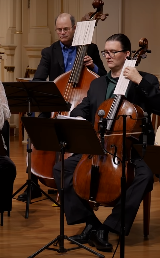Battalia à 10 on:
[Wikipedia]
[Google]
[Amazon]
 Battalia à 10 is a piece of
Battalia à 10 is a piece of
 ''Der Mars'' uses a particular paring of violone and solo violin. While the violin is playing trills and ornaments, the violone is instructed to imitate the sound of a
''Der Mars'' uses a particular paring of violone and solo violin. While the violin is playing trills and ornaments, the violone is instructed to imitate the sound of a

 Battalia à 10 is a piece of
Battalia à 10 is a piece of chamber music
Chamber music is a form of classical music that is composed for a small group of instruments—traditionally a group that could fit in a palace chamber or a large room. Most broadly, it includes any art music that is performed by a small numb ...
written by the Bohemian-Austrian composer Heinrich Ignaz Franz Biber
Heinrich Ignaz Franz Biber ( bapt. 12 August 1644, Stráž pod Ralskem – 3 May 1704, Salzburg) was a Bohemian-Austrian composer and violinist. Biber worked in Graz and Kroměříž before he illegally left his employer, Prince-Bishop Karl L ...
. The work is known for its early use of polytonality and non-conventional techniques. Written in 1673, ''Battalia'' is scored for 3 violin
The violin, sometimes known as a ''fiddle'', is a wooden chordophone (string instrument) in the violin family. Most violins have a hollow wooden body. It is the smallest and thus highest-pitched instrument (soprano) in the family in regular ...
s, 4 viola
The viola ( , also , ) is a string instrument that is bow (music), bowed, plucked, or played with varying techniques. Slightly larger than a violin, it has a lower and deeper sound. Since the 18th century, it has been the middle or alto voice of ...
s, 2 violone
The term violone (; literally "large viol" in Italian, " -one" being the augmentative suffix) can refer to several distinct large, bowed musical instruments which belong to either the viol or violin family. The violone is sometimes a fretted i ...
s, and continuo.
History
Though Biber's reason of the ''Battilia'' is uncertain, some scholars say it was the composer's feelings toward theThirty Years' War
The Thirty Years' War was one of the longest and most destructive conflicts in European history
The history of Europe is traditionally divided into four time periods: prehistoric Europe (prior to about 800 BC), classical antiquity (80 ...
, due to the high casualties (~50% of the German population and 1/3 of the Czechs).
Analysis
Sonata (Presto I)
The Sonata is in AB form; the B section uses a call and response motif, the response of which uses a staccatissimo mark to signal '' col legno'' or to hit the string with the back of the bow.Die liederliche Gesellschaft von allerley Humor (The Profligate Society of Common Humor)
The most famous, the second movement incorporates 8 melodies, but in different key and time signatures. One of the melodies is the folk song, "Cabbage and turnips have driven me away" (''Kraut und Rüben haben mich vertrieben''), similarly used in J. S. Bach's 30th Goldberg Variation, or the Quodlibet. Also some measures are in 12/8 time and the others in 4/4 time. There is aLatin
Latin (, or , ) is a classical language belonging to the Italic branch of the Indo-European languages. Latin was originally a dialect spoken in the lower Tiber area (then known as Latium) around present-day Rome, but through the power of the ...
footnote that reads ''hic dissonant ubique, nam enim sic diversis cantilenis clamore solent'' or "here it is dissonant everywhere, for thus are the drunks accustomed to bellow with different songs"
Allegro (Presto II)
The form is A-A-B-B, and uses left-hand pizzicato, which is indicated with a staccato dot. The movement feels irregular, referencing back to the war, symbolizing "uneasiness that the troops have inside them waiting for battle, while on the outside they show a sense of frivolity."Der Mars (The March)
 ''Der Mars'' uses a particular paring of violone and solo violin. While the violin is playing trills and ornaments, the violone is instructed to imitate the sound of a
''Der Mars'' uses a particular paring of violone and solo violin. While the violin is playing trills and ornaments, the violone is instructed to imitate the sound of a snare drum
The snare (or side drum) is a percussion instrument that produces a sharp staccato sound when the head is struck with a drum stick, due to the use of a series of stiff wires held under tension against the lower skin. Snare drums are often used ...
by placing a sheet of paper between the strings and the fingerboard. A similar section titled ''Musqetir Mars'' (Musketeer’s March) is used in the Sonata Representativa in A major.
Presto III
The third presto is canonic in nature with one interlocking theme with accompaniment as shown by the diagram at the bottom at this page.
Aria
Die Schlacht
German for "The War", the violones employ snap pizzicato, a technique famously used byBela Bartok
Bela may refer to:
Places Asia
*Bela Pratapgarh, a town in Pratapgarh District, Uttar Pradesh, India
*Bela, a small village near Bhandara, Maharashtra, India
*Bela, another name for the biblical city Zoara
* Bela, Dang, in Nepal
*Bela, Janakpur, ...
more than 200 years later.
Lamento Adagio
References
{{improve categories, date=May 2023 1673 compositions Compositions by Heinrich Ignaz Franz Biber Polytonality